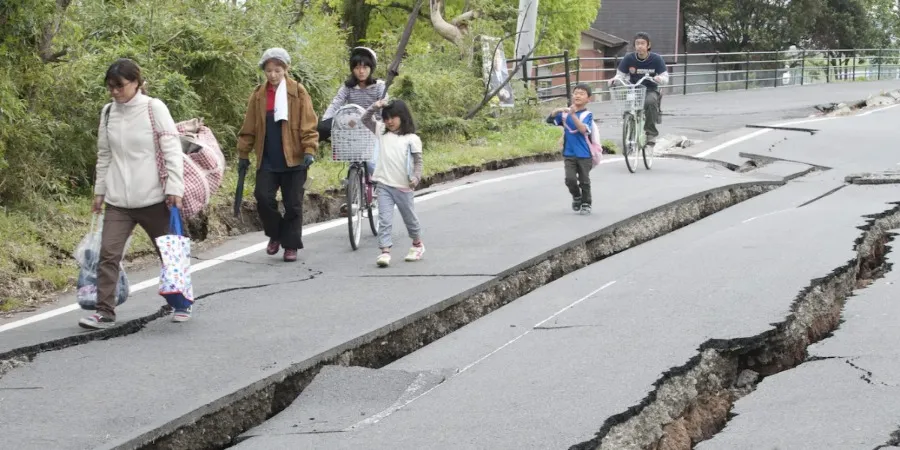
What to do in case of an earthquake in Japan?
As one of the most seismically active countries in the world, Japan is no stranger to earthquakes and tsunamis. The country even accounts for roughly 20% of the world’s earthquakes of 6 magnitude or greater.
Thus, Japanese people at a very young age have been carefully educated on how to react and seek protection if an earthquake hits their area. However, foreigners, especially those new to the country, oftentimes are not equipped with such knowledge. This can be extremely dangerous, especially for those living in areas prone to this national disaster such as prefectures along the coast of Japan.
In light of the recent devastating earthquake that struck the country at the beginning of this year, GoEMON thought that this would be the right time to guide everyone through the list of things that you can do to protect yourself and stay safe in an earthquake hits the country.
During an earthquake
1. If you are at home
Always remember the three rules: Drop, Cover, and Hold on
- Drop: Lowering your point of gravitation will help you better keep your balance
- Cover: Immediately hide under the table or any sort of furniture with the same structure. This would help prevent any heavy objects from falling onto you during the quake. Keep your head down low, cover your head with your hands,
- Hold on: Hold onto something to keep yourself in place in case of violent tremors
Stay away from windows and doors and make sure not to run out of the house while the earthquake is still ongoing. If needed, only evacuate after it earthquake has completely stopped.
2. If you are in the bathroom
- The first thing that you should do is open the bathroom door. However, only leave the room when the shaking has subsided. Once again, make sure to follow the Drop, Cover, and Hold on rule.
- If you happen to be taking a bath, cover your head with a bucket or anything available at the time. Try to get dressed as soon as possible and move to somewhere safer to wait for the earthquake to pass.
3. If you are inside public buildings
- Follow the Drop, Cover, and Hold on rule as usual. Try your best to stay calm and do not rush or push people to get to the exit. Make sure to be aware of other people around you and leave the building in an orderly manner. If there are staff there, follow their guidance.
- Stay away from shelves (especially in shopping malls) to prevent products from falling on to you due to the shaking.
Take your school bag or jacket to cover your head and run to open areas such as parks or other safe places to take refuge.
If you are near the ocean, run for safety because there is a possibility of a tsunami.
If you are in a crowded place, do not rush to the exit. Stay away from shelves containing easily
4. If you are outside
- Again, follow the Drop, Cover, and Hold on rule.
- Stay away from buildings (especially large ones), trees, electricity poles, etc. and immediately move to an open area to take cover. Pay extra attention to advertising signs, windows, and possible falling debris.
- Use emergency exits, not elevators as there is a possibility that there might be an aftershock.
5. If you are driving
- Pull over immediately and try to stay away from possible falling debris from trees, buildings, advertising signs, etc.
- If possible, try to wait in the car until the earthquake passes. Make sure to turn on the radio to catch emergency reports and the latest updates on what to do.
- In the case where evacuation is necessary, after pulling over, make sure to leave your car unlocked and with the keys in the ignition, so that rescue workers can move your car if needed.
After an earthquake
- After an earthquake, make sure to be up to date with public announcements over the TV, radio, or phone alert to know if you need to evacuate or not. In the case where evacuation orders are given, quickly grab some necessities and head to your designated temporary gathering sites (open public locations like parks where there are no buildings around).
- If you leave in coastal areas, don’t wait for an official announcement but evacuate immediately to higher grounds, as there is a high chance that a tsunami will follow.
- In bad cases where you are trapped inside or under rubble, cover your mouth and try to stay calm and steady your breathing. Don’t scream or shout, since it will only tire you and make you run out of energy and oxygen. Instead, try banging rhythmically on a pipe or wall, or send texts or post on social media (such as Twitter/X) to ask for help if you can use your phone.
- If you are in public buildings where there are many people, follow the guidance of staff and make sure to keep order.
- Immediately turn off your gas and make sure to be on alert for possible gas leaks. Make sure to turn off your circuit breaker if you have to evacuate.
- It is recommended to have an Earthquake Emergency Kit containing essential survival tools that you can quickly grab before leaving your house in cases where evacuation is needed. You can make your own kit, or buy pre-made ones.
Living in Japan, you should always be prepared for possible earthquakes and tsunamis. Stay safe, everyone!
Don’t forget to follow GoEMON Global for the latest updates on life in Japan!






